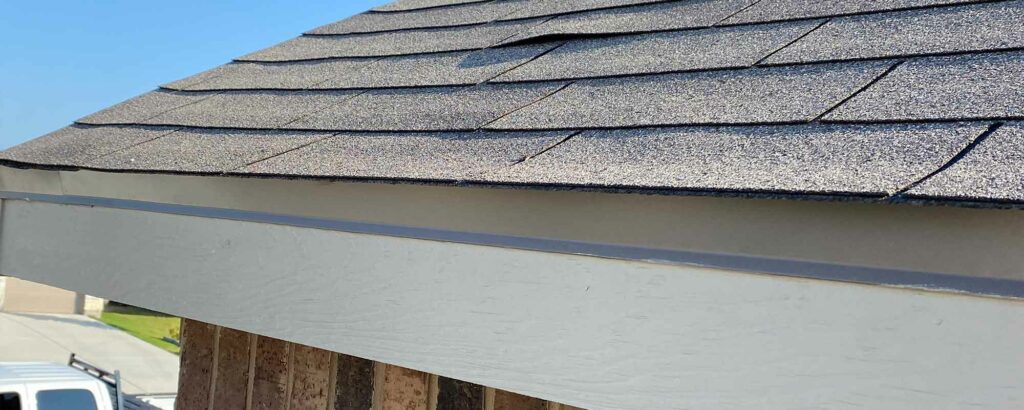In this article you will learn more about “What is a drip edge on a roof?”.
Whether your roof is built up from shingles, tiles, exposed felt underlay, metal, or any other classic roofing material, an aspect that every roof edge should have is the presence of drip edge flashing. But exactly is a roofing drip edge, what does it do, how much does it cost, and why is it necessary? If you’re finding yourself asking one or more of these questions, you’re in the right place.
We’ve put together this blog to explain the ins and outs of roof drip edges, elaborating on their purpose, why they’re an absolute necessity, and how much you can expect to pay for them to be installed.

What Exactly is Drip Edge and What Does It Do?
Drip edge is a form of metal flashing used on the edges of roofs to protect the surfaces underneath your shingles or tiles from water, along with keeping the fascia of your roof from getting wet and damaged. It’s installed under the primary roofing material to protect the more structural elements of the roof, essentially acting as a sort of seal.
Drip edge metal will vary between materials such as aluminum, steel, and copper, each of which is noted for its durability, non-staining, non-corroding, and generally waterproof nature. Without having a good drip edge on your roof, water can get through and cause serious damage to your home, even making its way to the foundations.
Why Does Your Roof Need a Drip Edge?
Beyond the protective reasoning that’s been outlined above, it’s worth noting that a properly-installed drip edge is a requirement by the building code. Code R905.2.8.5 of the 2018 IRC states that a drip edge must be installed to the edges of shingle roofs, and if this requirement isn’t met then you could risk your house being condemned due to not being up to code. While the code only explicitly states the requirement in relation to shingle roofs, it’s worth noting that it’s a definite recommendation for all roofing styles.
In some cases, a drip edge may not be totally necessary for shingle roofs, but this is only if there’s something in place acting like one already. If your roof’s fascia is pre-bent and plated with aluminum, then that will act as the roof’s drip edging, with the same rule applying to rake molding. Either of these things will essentially work in the same way as a drip edge, meaning you won’t need one specifically installed.
Some other reasons to invest in a drip edge include:
- More efficient gutter performance: The drip edge will lead rainwater more directly from the roof edge to the gutter, helping to maintain a consistent flow that combats clogs and build-ups.
- Added protection in colder months: Cold weather can be tough on your roof, with snow and ice bad for shingles and even worse for fascia boards. Letting it build up on the drip edge and then fall away will protect your roof’s foundations.
- Protection for your home’s edges: With a drip edge, water will drip away from the exterior body of your home, rather than dripping down and around it, meaning you have a degree of protection for your walls, railings, decking, and even the foundation.
- Added structural support: Being nailed into the roof decking and fascia means that a drip edge will also help to keep your roof’s internal boards from shifting and moving, keeping everything a bit sturdier.
At the end of the day, drip edging will help to extend the life of your roof, meaning repairs and replacements will be less regular and your home’s structural integrity will be protected better in general.
What Are Some Common Roof Drip Edge Types?
While a roof drip edge will generally be made from a metal like copper, aluminum, or steel, there are also three main styles of drip edge flashing that can be used on a roof edge.
- D-Metal or Hemmed Drip Edge: This drip edge style features an open hemmed bottom that leads off a flashing that bends over the edge of the roof and then back towards the house. This keeps the water moving down and away from the roof’s fascia
- L-Style Drip Edge: This is the shortest and most simple form of drip edging, with its name given for its L shape at 90 degrees. It features a shorter bottom flange and is commonly used on lower incline roofs with less intense drip offs.
- Gutter Apron or F-Style Drip Edge:This style gets its Gutter Apron title for generally running over the gutter and further away from the house. They’re similar to the L-style but they feature a longer leading stretch.
How Much Does a Drip Edge Cost?
Some roofers may try to neglect including drip edging in their initial quote, bringing it on as a surprise later or even attempting to avoid installing it altogether. Make sure to discuss the importance and cost of a drip edge with your preferred roofer prior to letting them undertake a project, otherwise, you may find yourself paying for it later.
Aluminum drip edging is the cheapest option, generally known to cost around $2.00 per linear foot including labor, however, you can expect to pay a fair amount more if you choose steel or copper. Note that labor costs will vary between different roofers, and this price is based on the drip edge being included in an overall roof replacement, and getting it installed separately will likely cost more.
Where to Go?
At Agave Roofing, we’re experts in everything shingle roof-related, including the installation of drip edges. Check out our website and get in touch for a quote if you have any questions or queries about shingle roofing in the greater San Antonio or Austin areas.